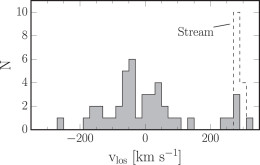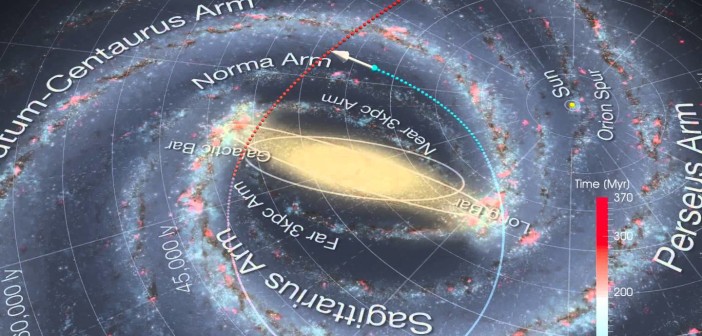Dwarf galaxies or globular clusters orbiting the Milky Way can be pulled apart by tidal forces, leaving behind a trail of stars known as a “stellar stream.” One such trail, the Ophiuchus stream, has posed a serious dynamical puzzle since its discovery. But a recent study has identified four stars that might help resolve this stream’s mystery.
Conflicting Timescales
The stellar stream Ophiuchus was discovered around our galaxy in 2014. Based on its length, which appears to be 1.6 kpc, we can calculate the time that has passed since its progenitor was disrupted and the stream was created: ~250 Myr. But the stars within it are ~12 Gyr old, and the stream orbits the galaxy with a period of ~350 Myr.
Given these numbers, we can assume that Ophiuchus’s progenitor completed many orbits of the Milky Way in its lifetime. So why would it only have been disrupted 250 million years ago?
Fanning Stream
Led by Branimir Sesar (Max Planck Institute for Astronomy), a team of scientists has proposed an idea that might help solve this puzzle. If the Ophiuchus stellar stream is on a chaotic orbit — common in triaxial potentials, which the Milky Way’s may be — then the stream ends can fan out, with stars spreading in position and velocity.
The fanned part of the stream, however, would be difficult to detect because of its low surface brightness. As a result, the Ophiuchus stellar stream could actually be longer than originally measured, implying that it was disrupted longer ago than was believed.
Search for Fan Stars
To test this idea, Sesar and collaborators performed a search around the ends of the stream, looking for stars that
- are of the right type to match the stream,
- are at the predicted distance of the stream,
- are located near the stream ends, and
- have velocities that match the stream and don’t match the background halo stars.

Histogram of the heliocentric velocities of the 43 target stars. Six stars have velocities matching the stream velocity. Two of these are located in the main stream; the other four may be part of a fan at the end of the stream. [Sesar et al. 2016]
That said, the mere evidence of a fan in the Ophiuchus stream suggests that its progenitor may have been on a chaotic orbit. If this is the case, it’s entirely possible that the progenitor could have survived for ~11 Gyr, only to have been disrupted within the last 0.5 Gyr. Detailed modeling and further identification of potential fan stars in the Ophiuchus stream will help to test this idea and resolve the puzzle of this stream.
Citation
Branimir Sesar et al 2016 ApJ 816 L4. doi:10.3847/2041-8205/816/1/L4


2 Comments
Pingback: cognitive dissonance and the Ophiuchus star stream
Pingback: La corriente de Ofiuco « SEDA / LIADA